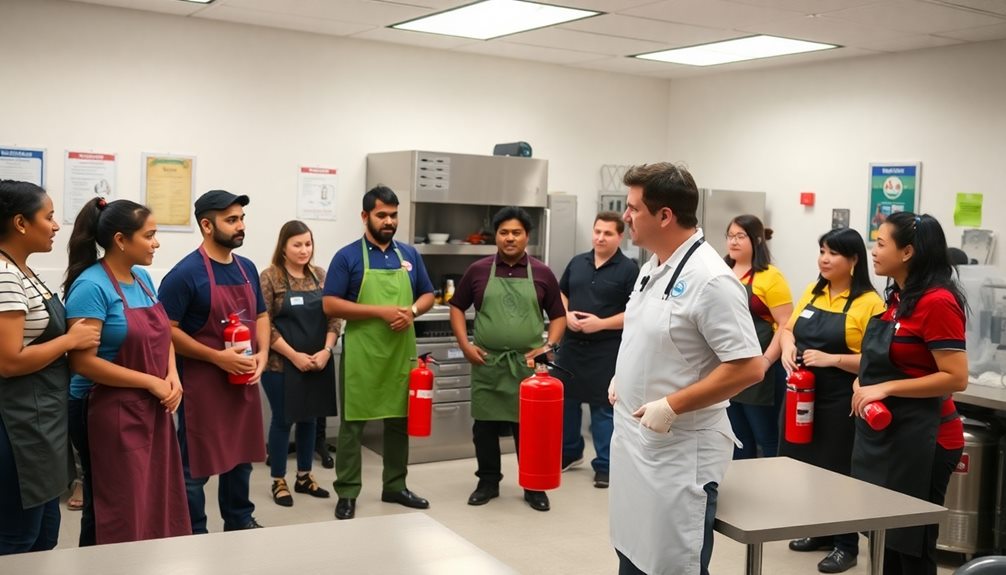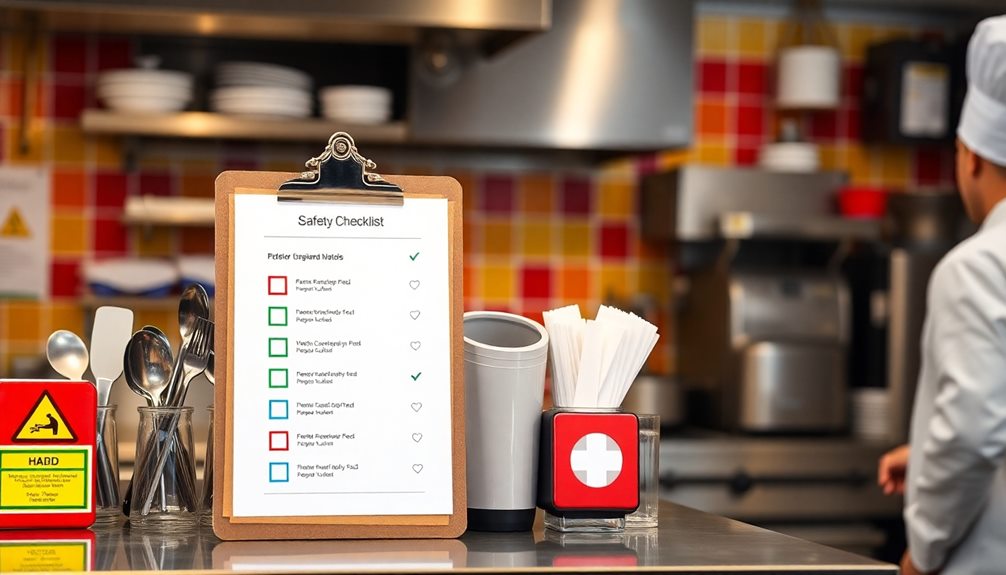A solid restaurant employee safety training guide is vital to protect your staff and customers. Start by covering essential topics like food handling, emergency procedures, and equipment safety. Regular training sessions keep safety top of mind and help identify potential hazards. Make use of available resources that cater to your diverse team, including bilingual materials and interactive tools. Engaging methods like hands-on demonstrations and role-playing enhance retention. By prioritizing ongoing education, you not only lower injury rates but also boost morale. Discover more strategies to create a safer restaurant environment in the sections ahead.
Key Takeaways
- Safety training is crucial in the restaurant industry to prevent injuries, especially for new and younger workers who are at higher risk.
- Essential topics include food handling, fire safety, emergency procedures, and equipment maintenance to ensure a safe working environment.
- Regular training sessions and interactive learning methods, such as hands-on demonstrations and quizzes, enhance employee engagement and knowledge retention.
- Bilingual training materials are available to accommodate diverse teams and improve understanding of safety protocols.
- Organizations like OSHAcademy offer specialized programs to enhance safety management skills across various restaurant roles.
Overview of Safety Training
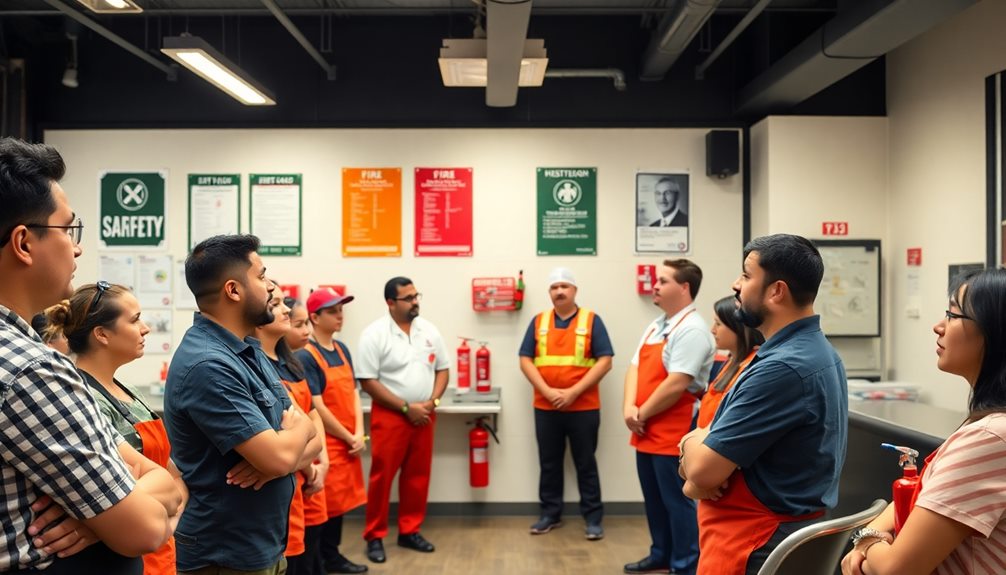
Safety training serves as the foundation for a secure restaurant environment. It's essential for you and your colleagues, helping identify potential hazards and mitigate workplace risks.
With 128 fatalities reported in the restaurant industry in 2021, effective safety training is imperative to minimize accidents and protect employee well-being.
As a new worker, you're particularly vulnerable, as first-year employees often experience a higher risk of injury. That's why thorough safety training programs are essential for all new hires.
Regular training sessions not only equip you with the necessary skills to perform your job safely but also contribute to a culture of safety within the workplace. This culture enhances overall employee morale, which can lead to better retention rates.
Organizations like OSHAcademy offer specialized safety training courses, ensuring you gain the knowledge required for compliance with safety regulations.
By participating in these programs, you'll be better prepared to handle potential dangers, ultimately making the restaurant a safer place for everyone.
Significance of Safety Practices
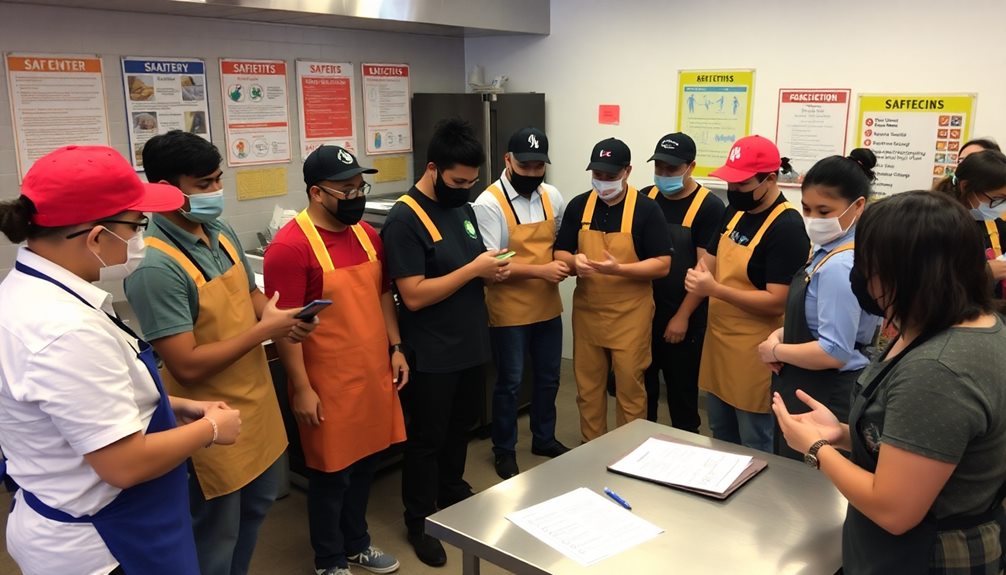
Understanding the importance of safety practices in a restaurant isn't just about compliance; it's about protecting yourself and your coworkers. With a high injury rate of 2.6 non-fatal injuries per 100 employees, safety training becomes crucial, especially for younger workers aged 16-19, who face the highest risks in the service industry.
By participating in extensive safety training, you help identify potential hazards, which can greatly reduce the risk of accidents and injuries. Additionally, engaging in regular safety training cultivates a sense of empowerment and resilience among staff, contributing to a more proactive approach to workplace safety embracing burnout recovery.
In 2021, the restaurant industry recorded 128 fatalities, underscoring the urgent need for effective safety practices. Engaging in regular safety training not only promotes a culture of safety but also boosts employee morale and retention. When everyone feels safe, job performance improves, benefiting both you and the business.
Furthermore, adhering to safety practices guarantees compliance with health regulations, which is essential for maintaining your restaurant's reputation and minimizing liability risks.
Structured safety training programs are designed to tackle the unique challenges you face in the restaurant environment. By investing in safety training, you're not just following rules; you're creating a safer workplace for everyone.
Essential Safety Topics
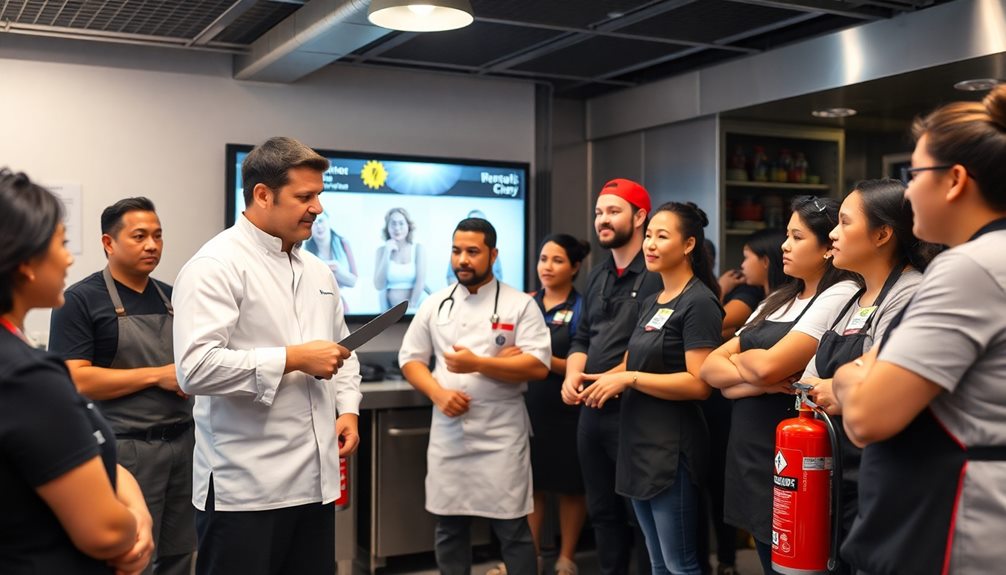
Building on the significance of safety practices, it's crucial to focus on specific topics that directly impact your daily operations. First, make sure that all employees receive thorough training in food handling and sanitation. This is critical for maintaining hygiene and preventing foodborne illnesses that could harm customers and damage your restaurant's reputation.
Additionally, consider implementing advance directives to guide decision-making in case of emergencies involving employees. Next, address fire safety and emergency procedures. Given the high risk of fire hazards in food service, everyone must understand how to respond effectively. Regular training is especially important for young workers, who face high injury rates in the industry.
Also, emphasize equipment safety and maintenance training. Proper use of kitchen tools, like knives, is vital to prevent serious injuries. Incorporating best practices in your training materials will help reinforce these lessons.
Lastly, prioritize customer safety and incident response training. Accidents can lead to injuries and liability issues, so having a well-prepared staff is essential.
Accessing Training Resources
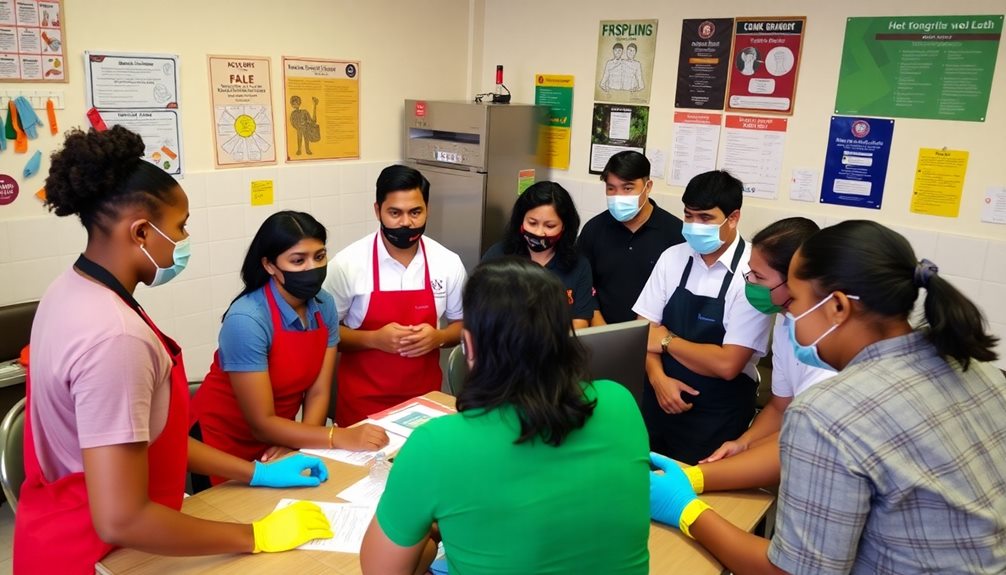
You'll find that training resources are available in both English and Spanish, making it easier for your diverse team to understand safety protocols.
Plus, all materials are downloadable and can be printed for your in-house training sessions.
This accessibility helps guarantee that everyone on your staff is well-prepared to maintain a safe working environment.
Bilingual Resource Availability
Accessing bilingual training resources is vital for fostering a safe work environment in California's diverse restaurant industry. With materials available in both English and Spanish, you can guarantee that all employees understand significant safety protocols related to food handling and preparation. This inclusivity not only enhances safety but also boosts team morale.
To make the training experience more effective, consider the following resources:
| Resource Type | Description |
|---|---|
| Downloadable Materials | Flexible access for tailored training sessions. |
| Printable Formats | Easy integration into daily operations. |
| Interactive eTools | Engage employees and reinforce safety knowledge. |
Regular updates to these training materials reflect the latest safety standards, meaning your staff will always have access to the most relevant information. Plus, interactive quizzes help reinforce what your employees learn. By leveraging these bilingual resources, you're not just meeting compliance standards—you're creating a culture of safety that benefits everyone in your restaurant, from the kitchen to the front of the house. Remember, effective training means safer food practices and a more efficient workplace.
Downloadable Training Materials
Whether you're a seasoned restaurant owner or new to the industry, having downloadable training materials at your fingertips can greatly enhance your team's safety knowledge. These resources are available in both English and Spanish, guaranteeing you cater to a diverse workforce.
You can access them online for flexible learning, allowing you to integrate training into your busy schedule seamlessly. Additionally, the printable formats of these materials enable you to conduct in-house training sessions, promoting hands-on learning for your staff.
This approach not only engages your team but also reinforces the importance of safety in the restaurant industry. Regular updates to the training resources guarantee that your operations remain compliant with current health regulations, helping you maintain a safe environment for both employees and customers.
If you're looking to streamline access, you can set up a free business account, which takes just 1-2 business days. This account provides you with easy access to even more training materials tailored specifically to your restaurant's needs.
Effective Implementation Strategies

To effectively implement safety training, you should schedule regular sessions that keep safety top of mind for your team.
Incorporating interactive learning methods, like quizzes and hands-on demonstrations, makes the training more engaging and memorable.
This approach not only boosts retention but also fosters a stronger safety culture in your restaurant.
Regular Training Schedule
Implementing a regular training schedule is essential for keeping your restaurant staff informed about safety protocols and practices.
To guarantee your team stays safe, make sure you schedule safety training sessions at least quarterly. This helps combat the high injury rates in the restaurant industry, especially among younger workers.
Here are some effective strategies for your training schedule:
- Conduct quarterly sessions: Regular training keeps everyone up to date with the latest safety protocols.
- Engage staff actively: Use hands-on demonstrations and quizzes to reinforce learning and maintain interest.
- Monitor compliance: Assess knowledge through feedback and tests to identify gaps and improve training effectiveness.
- Foster a safety culture: Encourage staff to report hazards and participate in discussions, which can help reduce injuries and fatalities.
Interactive Learning Methods
Engagement is fundamental when it comes to effective safety training in restaurants. To boost participation, incorporate hands-on activities and role-playing scenarios in your training sessions. These methods enhance engagement and help employees retain essential safety information.
For younger workers, utilize interactive eTools and quizzes to make learning dynamic and enjoyable. Regular feedback assessments are important for gauging employee understanding. By checking how well your team adapts to safety protocols, you can guarantee continuous improvement in your training effectiveness.
Encourage your employees to participate in safety committees or discussions, allowing them to voice concerns and contribute to safety strategies. This not only fosters a culture of safety but also empowers your team.
Additionally, leverage multimedia resources, like video segments that showcase safety practices, to cater to various learning styles. These resources make training sessions more impactful and relatable.
Young Worker Safety Guidelines
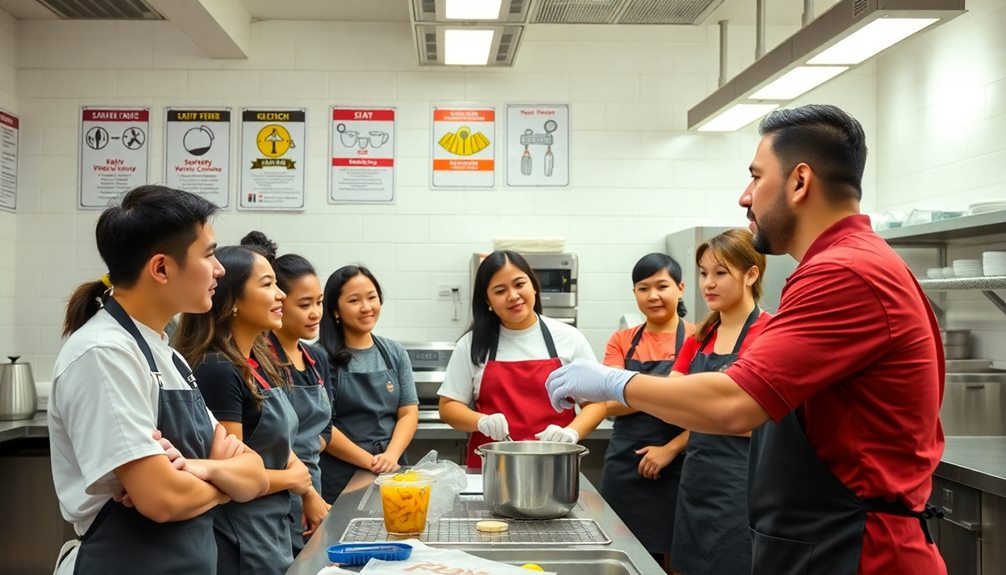
When it comes to guaranteeing a safe working environment, young workers in the restaurant industry face unique challenges that demand specific safety guidelines. Given that they represent 30% of the workforce, it's vital to focus on their safety training.
Sadly, in 2017, 22 youths under 18 lost their lives due to work-related injuries, highlighting the urgent need for tailored safety education.
To help protect young workers, consider these essential safety guidelines:
- Provide thorough training: Use resources like OSHA's interactive eTools to educate young employees on workplace hazards.
- Encourage open communication: Foster an environment where young workers feel comfortable discussing safety concerns and asking questions.
- Supervise closely: Guarantee that young workers are monitored by experienced staff, particularly during high-risk tasks.
- Involve parents: Educate parents about potential hazards and encourage them to engage in their child's safety training.
Statistics on Injuries
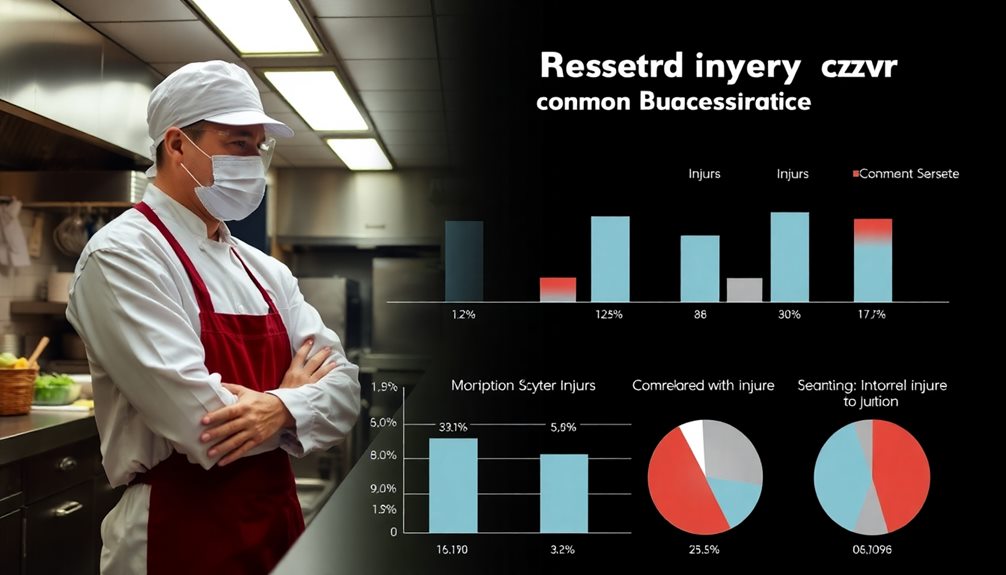
Young workers in the restaurant industry often face heightened risks, and understanding the statistics surrounding workplace injuries can shed light on the importance of safety training.
In 2021 alone, the restaurant industry recorded 128 fatalities, underscoring the critical need for effective safety measures. You might be surprised to learn that there are 2.6 non-fatal injuries per 100 employees in this sector, indicating a significant prevalence of workplace accidents.
Particularly concerning is the fact that the service industry has the highest injury rates among workers aged 16-19, highlighting your vulnerability in this field.
In 2017, about 27,070 youths were reported sickened or injured while working in restaurants, which points to a pressing need for targeted safety training aimed at young workers like you.
First-year workers are at an even greater risk of injury, making thorough safety training essential for new hires in the restaurant industry.
OSH Programs Available
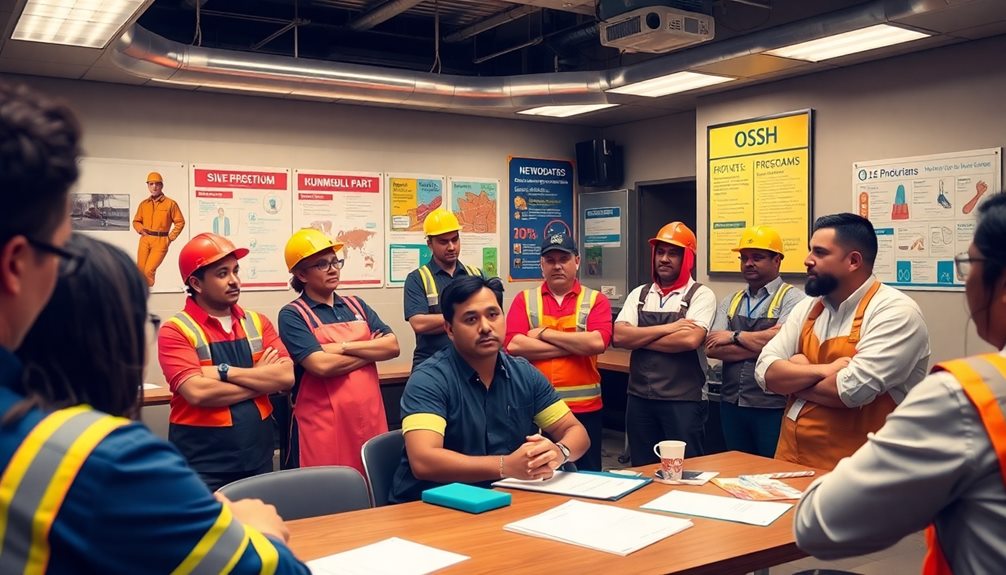
Recognizing the importance of safety in the restaurant industry, several Occupational Safety and Health (OSH) programs are available to help you and your colleagues enhance workplace safety.
These programs cater to various roles and responsibilities, ensuring you receive the training that fits your needs and career aspirations.
Here's a brief overview of some key OSH programs you can consider:
- OSH Professional Program: A thorough 132-hour training aimed at advancing your career in occupational safety and health management.
- OSH Manager Program: This 48-hour program focuses on implementing safety management systems, improving safety protocols in your workplace.
- OSH Supervisor Program: Lasting 36 hours, this program emphasizes the essential duties of safety supervisors, helping you effectively manage and promote a safe environment.
- Train-the-Trainer Program: Also 36 hours long, this course equips you with the skills to deliver impactful safety training to your coworkers.
Kitchen and Food Truck Safety
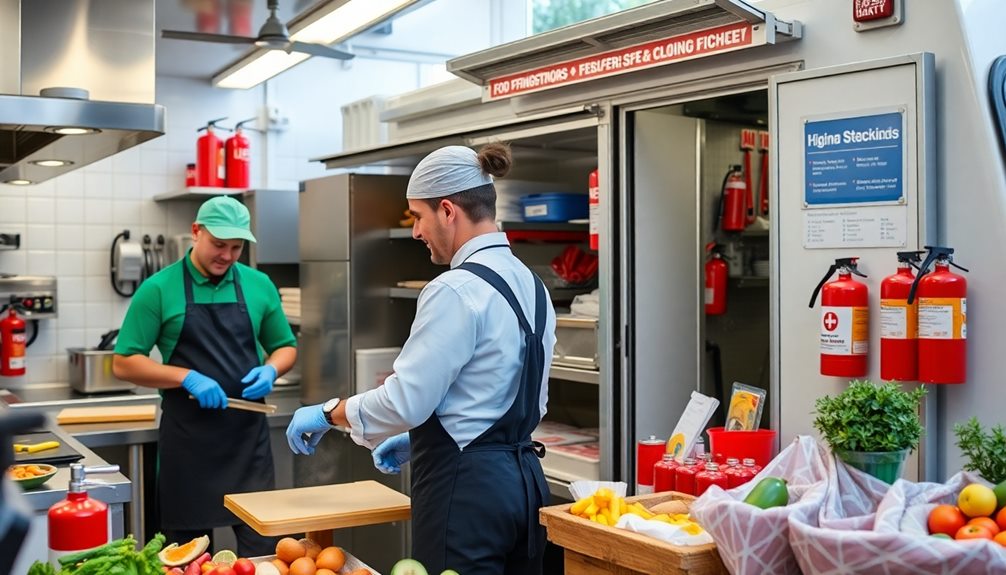
Kitchen and food truck safety is crucial in preventing injuries and guaranteeing a smooth operation. You need to recognize common hazards like cuts and burns. To minimize these risks, use proper knife handling techniques and install non-slip mats in areas where spills are likely.
For food truck operators, propane safety is critical. Make certain you adhere to propane guidelines and conduct regular safety inspections to confirm all equipment works correctly, preventing accidents during busy service times.
Familiarize yourself with the checklists provided by the National Fire Protection Association, which enhance safety protocols and prepare you for emergencies.
Understanding emergency procedures is imperative, especially during hazardous situations. Make certain you and your team are trained on how to respond effectively, safeguarding both staff and customers.
Safety Training Techniques
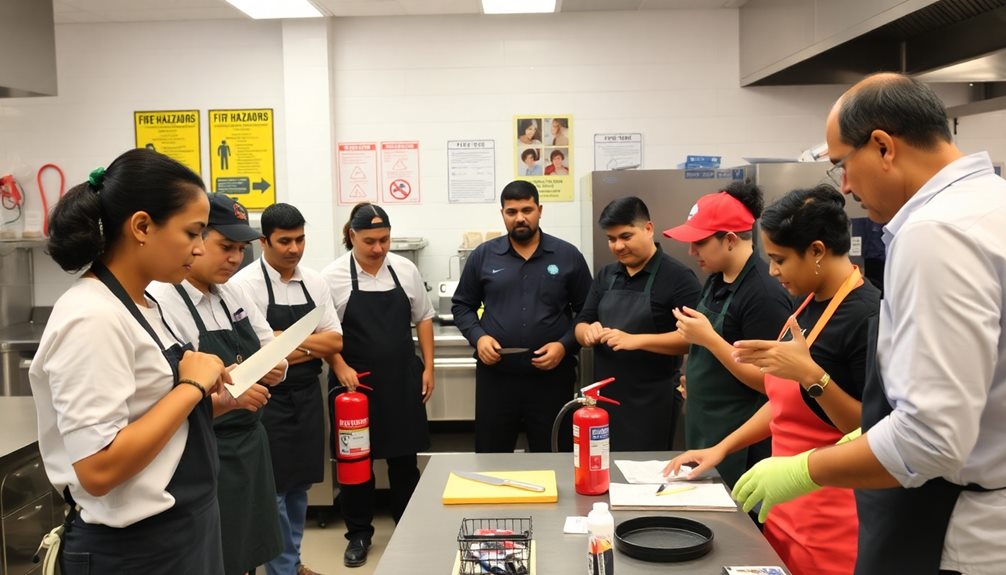
Effective safety training techniques are vital for creating a secure restaurant environment. To guarantee your employees understand and retain safety concepts, you'll want to incorporate various interactive methods. Here are some key techniques to take into account:
- Role-playing and simulations: These methods actively engage employees and help them practice safety protocols in realistic scenarios.
- Regular training sessions: Schedule ongoing education to keep safety top-of-mind and reduce the risk of accidents and injuries.
- Bilingual materials: Use training resources in both English and Spanish to cater to a diverse workforce, making sure everyone comprehends the material.
- Feedback and assessments: Monitor the effectiveness of your training through evaluations and employee feedback, allowing for necessary adjustments to improve future sessions.
Additionally, it's important to foster a workplace culture that prioritizes safety. Encourage open communication about potential hazards and empower employees to participate in safety committees or training sessions.
Frequently Asked Questions
What Are the 7 General Guidelines for Workplace Safety as Recommended by OSHA?
OSHA emphasizes seven guidelines for workplace safety: identify hazards, provide PPE, conduct regular training, maintain equipment, guarantee compliance with regulations, implement a reporting system, and perform regular inspections to enhance safety culture and practices.
How Do You Train a Restaurant Employee Effectively?
You've got to transform training into an epic adventure! Immerse yourself in interactive sessions, release hands-on demos, and spice it up with quizzes. Keep feedback flowing, and watch your team become safety superheroes in no time!
How Do You Train Employees in Food Safety?
To train employees in food safety, incorporate engaging methods like hands-on demonstrations and eLearning. Regular assessments, bilingual materials, and refresher courses keep everyone informed and compliant with the latest safety regulations.
What Safety Training Is Required by OSHA?
OSHA requires you to receive training on workplace hazards like slips, trips, and falls. You must learn to handle hazardous materials safely, use equipment correctly, and know emergency procedures to guarantee your safety at work.
Conclusion
To sum up, prioritizing safety training in your restaurant is like laying a solid foundation for a house—it supports everything built on top. When you invest time in teaching essential safety practices, you're not just protecting your employees; you're also safeguarding your business's future. Remember, a well-trained team can turn potential hazards into opportunities for growth. So, make safety a part of your daily operations, and watch your establishment thrive in a secure environment.
